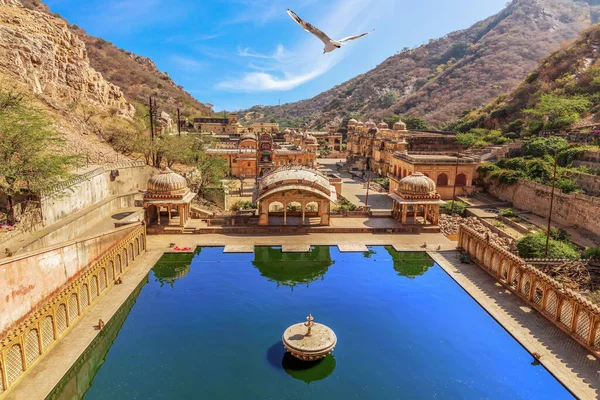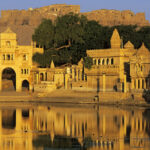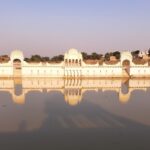Exploring the Spiritual Heart of Jaipur: A Journey Through Its Religious Places
Jaipur, the vibrant capital of Rajasthan, is renowned not only for its royal palaces and historic forts but also for its rich tapestry of religious sites. Each of these sacred places offers a unique glimpse into the city’s diverse faiths and traditions, making them fascinating destinations for both pilgrims and tourists. Here’s a guide to some of Jaipur’s most significant religious locations:
1. Govind Dev Ji Temple
Nestled in the City Palace complex, the Govind Dev Ji Temple is dedicated to Lord Krishna, a central figure in Hindu worship. This temple is renowned for its beautiful idol of Krishna, believed to be self-manifested. The temple’s architecture blends traditional Rajasthani style with intricate marble work, creating a serene ambiance. The daily rituals, including the mesmerizing “Aarti” (a devotional song performed in front of the deity), attract devotees from across the country. Visiting this temple provides a spiritual experience enriched by both the devotion of its worshippers and the temple’s historical significance.
2. Birla Mandir
Perched on a hill overlooking Jaipur, the Birla Mandir, also known as the Lakshmi Narayan Temple, is an architectural marvel. Constructed from white marble, this temple is dedicated to Lord Vishnu and Goddess Lakshmi. Its contemporary design contrasts beautifully with traditional Rajasthani temples. The temple’s tranquil atmosphere and breathtaking city views offer a peaceful retreat from the bustling streets below. The intricately carved marble walls depict various Hindu deities and mythological scenes, making it a visual and spiritual feast.
3. Jain Temple in Johari Bazaar
Located in the heart of Johari Bazaar, the Jain Temple, or Shri Digamber Jain Temple, is a testament to Jain architectural brilliance. Dedicated to Tirthankara Adinatha, the temple showcases exquisite marble carvings and ornate design. The Jain community’s dedication to non-violence and simplicity is reflected in the temple’s serene and minimalist ambiance. The inner sanctum, adorned with detailed sculptures and frescoes, provides an insightful look into Jain spiritual practices and beliefs.
4. Galtaji Temple
Situated amidst the Aravalli hills, the Galtaji Temple complex consists of a cluster of temples and holy springs. Often referred to as the Monkey Temple due to the large population of monkeys in the area, Galtaji is dedicated to Lord Rama and other Hindu deities. The temple’s natural springs are believed to have healing properties, and pilgrims visit to take a holy dip. The ancient architecture, coupled with the picturesque setting and spiritual significance, makes Galtaji a must-visit for those seeking tranquility and spiritual renewal.
5. Moti Doongri Temple
The Moti Doongri Temple, located on a small hill, is dedicated to Lord Ganesh, the elephant-headed deity revered as the remover of obstacles. The temple’s location provides panoramic views of the city and is an excellent spot for reflection and worship. The interior of the temple, with its vibrant decorations and serene atmosphere, invites devotees to engage in prayer and meditation. The annual Ganesh Chaturthi festival, celebrated with great enthusiasm here, adds a festive touch to the temple’s otherwise calm environment.
6. Ajmeri Gate Mosque
Located near the Ajmeri Gate, this mosque represents the Islamic heritage of Jaipur. The mosque’s architecture features traditional Mughal design elements, including intricate arches and minarets. It stands as a symbol of Jaipur’s religious diversity and the harmonious coexistence of different faiths. The mosque serves as a place of worship for the Muslim community and is an intriguing site for those interested in exploring the Islamic architectural influence in Rajasthan.
7. Shri Chandra Shekhar Ji Temple
Dedicated to Lord Shiva, the Shri Chandra Shekhar Ji Temple is another significant spiritual site in Jaipur. It is known for its serene atmosphere and the majestic Shiva idol that is the temple’s centerpiece. Although smaller in scale compared to some of the grand temples, the temple’s design is profound in its spiritual impact. It is a popular destination for devotees seeking blessings and peace of mind.
8. St. Andrews Church
For those interested in Christian religious sites, St. Andrews Church is a noteworthy landmark in Jaipur. Established during the British era, the church’s Gothic Revival architecture and stained-glass windows offer a glimpse into the colonial past of the city. The church’s peaceful ambiance and historical significance make it a reflective place for visitors of all backgrounds.
9. Shri Ram Mandir
Situated in the heart of the city, Shri Ram Mandir is dedicated to Lord Rama, an incarnation of Vishnu and a revered figure in Hinduism. The temple’s vibrant decorations and lively atmosphere during festivals like Ram Navami reflect the deep devotion of its followers. The temple’s community activities and religious events contribute to its role as a spiritual hub in Jaipur.
10. Khandar Sahib Gurudwara
A significant site for the Sikh community, the Khandar Sahib Gurudwara provides a space for reflection and community service. The Gurudwara, with its simple yet profound design, serves as a center for spiritual learning and social welfare. Visitors are welcomed with traditional Sikh hospitality, and the community kitchen (Langar) offers free meals to all, embodying the Sikh principle of selfless service.
Jaipur’s religious sites are not merely places of worship but also repositories of the city’s rich cultural and historical heritage. Each temple, mosque, church, and gurudwara tells a story of faith, architectural grandeur, and the diverse tapestry of beliefs that shape this historic city. Whether you’re a pilgrim seeking spiritual solace or a traveler exploring the multifaceted heritage of Jaipur, these religious sites offer an enriching experience that transcends mere sightseeing.
For more information on exploring the spiritual and cultural heritage of Jaipur, check out our Rajasthan Tour Packages.
1. Govind Dev Ji Temple
Q: What is the importance of the Govind Dev Ji Temple in Jaipur?
A: The Govind Dev Ji Holy place, located in the City Royal residence facility, is committed to Lord Krishna. It is renowned for its stunning idol of Krishna, thought to be self-manifested. The temple’s blend of standard Rajasthani style with intricate marble work produces a calm ambience. The day-to-day routines, consisting of the captivating “Aarti” (a devotional tune performed before the deity), draw enthusiasts from across the nation, enriching visitors with both spiritual and historic relevance.
2. Birla Mandir
Q: What makes Birla Mandir a building wonder?
A: Set down on a hill, the Birla Mandir, additionally referred to as the Lakshmi Narayan Temple, is built from white marble and devoted to Lord Vishnu and Siren Lakshmi. Its modern design contrasts beautifully with conventional Rajasthani temples. The holy place offers a relaxing hideaway with its tranquil atmosphere and breathtaking city views, enhanced by intricately carved marble walls illustrating Hindu deities and mythical scenes.
3. Jain Temple in Johari Fete
Q: What is remarkable about the Jain Holy Place in Johari Fair?
A: The Jain Holy Place, or Shri Digamber Jain Holy place, located in Johari Mart, is a testimony to Jain building radiance. Committed to Tirthankara Adinatha, it includes charming marble makings and elaborate style. The temple’s minimal and tranquil setting reflects the Jain area’s commitment to non-violence and simpleness, supplying an informative check out Jain spiritual techniques and beliefs.
4. Galtaji Temple
Q: Why is Galtaji Temple also referred to as the Monkey Holy place?
A: Galtaji Holy place, established in the middle of the Aravalli hills, is often referred to as the Monkey Holy place because of the large populace of apes in the location. Committed to Lord Rama and various other Hindu deities, the temple complex features natural springs believed to have recovery residential or commercial properties. Pilgrims check out to take a divine dip, and the ancient architecture incorporated with the attractive setup makes it a tranquil place for spiritual revival.
5. Moti Doongri Holy Place
Q: What is the significance of the Moti Doongri Temple in Jaipur?
A: The Moti Doongri Holy place, located on a small hillside, is devoted to Lord Ganesh, the elephant-headed deity admired as the cleaner of challenges. The holy place gives panoramic views of the city and is a wonderful area for representation and worship. Its vivid decorations and tranquil atmosphere welcome enthusiasts to petition and meditation, with the Ganesh Chaturthi celebration adding a festive touch to its serene setting.
6. Ajmeri Entrance Mosque
Q: How does the Ajmeri Entrance Mosque mirror Jaipur’s Islamic heritage?
A: The Ajmeri Gateway Mosque stands for Jaipur’s Islamic heritage with its conventional Mughal style aspects, consisting of complex arches and turrets. It represents the city’s spiritual variety and the harmonious conjunction of different confidences. The mosque functions as a place of worship for the Muslim neighborhood and is an intriguing site for exploring the Islamic architectural influence in Rajasthan.
7. Shri Chandra Shekhar Ji Temple
Q: What is special concerning the Shri Chandra Shekhar Ji Holy Place?
A: Committed to Lord Shiva, the Shri Chandra Shekhar Ji Temple is understood for its relaxed environment and the magnificent Shiva idolizer that is the centerpiece. Though smaller sized contrasted to some grand temples, its extensive spiritual impact makes it a preferred site for enthusiasts seeking blessings and comfort.
8. St. Andrews Church
Q: What historical value does St. Andrews Church hold?
A: St. Andrews Church, established during the British age, includes Gothic Revival design and stained-glass home windows. It provides a look into Jaipur’s colonial past, with its calm ambiance and historic worth making it a reflective location for site visitors of all histories.
9. Shri Ram Mandir
Q: What are the highlights of Shri Ram Mandir in Jaipur?
A: Shri Ram Mandir, dedicated to Lord Rama, shows the deep commitment of its followers with its vibrant decorations and vibrant environment during celebrations like Ram Navami. The temple’s neighborhood tasks and religious occasions add to its function as a spiritual hub in Jaipur.
10. Khandar Sahib Gurudwara
Q: What makes Khandar Sahib Gurudwara a significant website for the Sikh community?
A: Khandar Sahib Gurudwara serves as a facility for spiritual learning and community service. With its simple yet profound layout, it symbolizes the Sikh concept of generous service. Site visitors are welcomed with typical Sikh friendliness, and the neighborhood kitchen (Langar) supplies free meals to all. Jaipur’s religious websites are not simply places of worship however additionally databases of the city’s abundant social and historic heritage. Each holy place, mosque, church, and gurudwara tells a story of confidence, architectural magnificence, and the diverse tapestry of ideas that form this historic city. Whether you’re an explorer seeking spiritual solace or a tourist discovering Jaipur’s diverse heritage, these res on discovering the spiritual and social heritage of Jaipur, look into our Rajasthan Excursion Packages.ligious websites provide an enriching experience that goes beyond plain taking in the sights.



